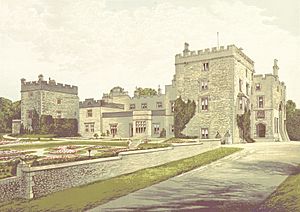Muncaster Castle facts for kids
Quick facts for kids Muncaster Castle |
|
|---|---|
 |
|
| Location | Lake District National Park |
| Area | Cumberland |
| Built | 13th century |
| Rebuilt | 1862–1866 |
| Architect | Anthony Salvin |
| Owner | Private |
|
Listed Building – Grade I
|
|
| Official name: Muncaster Castle | |
| Designated | 7 September 1967 |
| Reference no. | 1068780 |
| Lua error in Module:Location_map at line 420: attempt to index field 'wikibase' (a nil value). | |
Muncaster Castle is a historic castle in Cumbria, England. It is privately owned and sits near the River Esk. The castle is about one mile east of the village of Ravenglass. It is a very important building, listed as a Grade I historic site.
Contents
History of Muncaster Castle
Early Beginnings and Roman Connections
The name "Muncaster" comes from an older name, "Mulcaster." This name first appeared around 1150. The word "Muncaster" includes the Latin word castra, which means "fort" or "camp."
People think the castle might be built on old Roman foundations. These could have been part of a small fort. This fort would have supported the larger Roman fort of Glannoventa at Ravenglass.
Building the Castle
The land where Muncaster Castle stands was given to Alan de Penitone in 1208. The oldest parts of the castle are from the 13th and 14th centuries. These include the Great Hall and a special type of watchtower called a pele tower. Pele towers were common along the border between England and Scotland.
Changes Over Time
Between 1860 and 1866, a famous architect named Anthony Salvin made many changes to Muncaster Castle. He worked for the Barons Muncaster. Later, in 1916, Sir John Frecheville Ramsden discussed more changes with another architect, Edwin Lutyens. However, these plans did not happen. Lutyens did design the Muncaster War Memorial, which was built in 1922.
Muncaster During World War II
During the Second World War, Muncaster Castle helped keep important art safe. About 700 artworks from the Tate Gallery were moved there. These included paintings by famous artists like Turner, Manet, and Van Gogh.
Muncaster Today
The Pennington family still owns Muncaster Castle. They have lived there for over 800 years. It is still their family home. For 30 years, Phyllida Gordon-Duff-Pennington and her husband Patrick worked hard to fix up the castle. They turned it from an old ruin into a popular place for visitors and events.
Since 2021, Peter and Iona Frost-Pennington are the owners. Their son, Ewan, helps manage the castle. More than 90,000 people visit Muncaster Castle each year. In October 2021, the castle received money from the government's Culture Recovery Fund. This helped support its continued operation.
Muncaster Castle also hosts a weekly 5k run called the Muncaster Castle parkrun. It happens every Saturday morning.
Castle Gardens and Attractions
Muncaster's gardens are designed to offer amazing views. You can see the Esk Valley and the mountains. The castle has an aviary with owls and other birds of prey. These birds come from Britain and other countries. Visitors can watch daily flying displays. There is also an indoor maze that tells the story of a field vole.
The Luck of Muncaster
There is a special story about a glass bowl at Muncaster Castle. After a battle in 1464, King Henry VI was given shelter at the castle by Sir John Pennington. The king gave Sir John a beautiful Venetian glass drinking bowl. He wished that "As long as this bowl remains unriven, Penningtons from Muncaster never shall be driven." This means as long as the bowl doesn't break, the Pennington family will stay at Muncaster. The glass is still at the castle and is called "The Luck of Muncaster." It is still in one piece!
Tom Fool
A medieval jester named Thomas Skelton worked for the Pennington family. People say he was the original "Tom Fool." His picture hangs in the castle. Muncaster Castle also holds an annual competition in his honor.
See also
- Grade I listed buildings in Cumbria
- Listed buildings in Muncaster
- Castles in England
- List of historic houses in England


